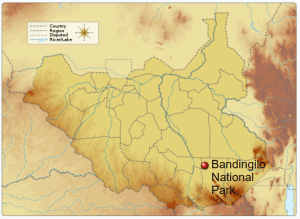
Bandingilo National Park

The Bandingilo National Park, (sometimes Badingilo) is a national park located in South Sudan’s Equatoria region. Founded in 1992, it is situated in a wooded area near the White Nile river, covering 10,000 square kilometres (3,900 sq mi). Large marshlands stretching up into Jonglei state are also found within the park.
The world’s second-largest annual animal migration (second only to the migration in the Serengeti occurs partly in this reserve, when multiple species of antelope, including Bohor reedbuck, tiang, and white-eared kob, move between this reserve and Boma National Park. In 2021 it was estimated the migration included 1 million kob and 200,000 tiang. The migration happens from January to June. The animals move from Bandingilo into Boma and the Gambella National Park in Ethiopia. Then the pattern is reversed from November to January.
The park is also home to the critically endangered species of the Nubian giraffe, Northeast African cheetah, and Northern lion. Additionally there are African wild dog, caracal, and spotted hyena. The park supports large bird populations, estimated to be 400 species in 2021.It has been named as an Important Bird Area.
During the wet season, the grasslands are flooded. Then during dry season there is extensive burning. This helps maintain the grassland habitats.
On 6 July 2011, three days before South Sudan formally seceded from Sudan, an administrative headquarters was officially opened at a ribbon-cutting ceremony led by Central Equatoria Governor Clement Wani.In August 2022, African Parks signed a 10-year renewable agreement with the government of South Sudan to manage Bandingilo and Boma National Parks. Prior to that the parks were managed by the Ministry of Environment and Forestry, and the Ministry of Wildlife Conservation and Tourism.
The 22-year long war between Sudan and South Sudan did not appear to affect the animal populations in the area the park now covers But the development of the new country became a threat. Additional conflict lasted from around 2013 to 2020. As of 2021, conservationists are unable to monitor the effects to animal populations and habitats. Though a major wildlife preserve, the park lies within a Total S.A. oil concession, potentially exposing it to surveying and drilling. Having said this, given the large migration that occurs here, we could expect huge pressure on any western oil company that joined such a project (the western company who was going to drill in the Virungas, backed out, we should be ready to put pressure on anyone doing something similar in the near future.
Whether tourism infrastructure is going to recover quickly is questionable, we will add this as a destination as soon as we have partners on the ground.










